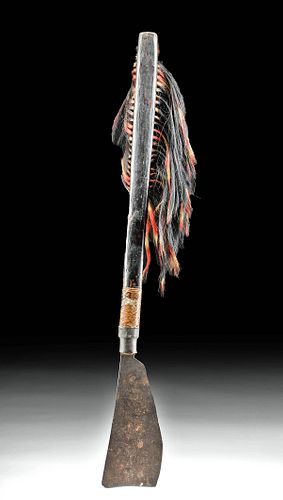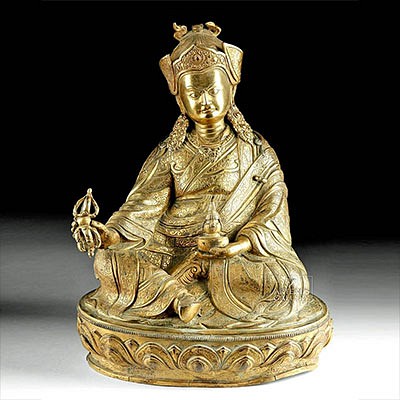19th C. Indian Naga Wood & Iron Sema Dao w/ Hair Tassel
Lot 109
About Seller
Artemis Gallery
686 S Taylor Ave, Ste 106
Louisville, CO 80027
United States
Selling antiquities, ancient and ethnographic art online since 1993, Artemis Gallery specializes in Classical Antiquities (Egyptian, Greek, Roman, Near Eastern), Asian, Pre-Columbian, African / Tribal / Oceanographic art. Our extensive inventory includes pottery, stone, metal, wood, glass and textil...Read more
Estimate:
$700 - $1,000
Absentee vs Live bid
Two ways to bid:
- Leave a max absentee bid and the platform will bid on your behalf up to your maximum bid during the live auction.
- Bid live during the auction and your bids will be submitted real-time to the auctioneer.
Bid Increments
| Price | Bid Increment |
|---|---|
| $0 | $25 |
| $300 | $50 |
| $1,000 | $100 |
| $2,000 | $250 |
| $5,000 | $500 |
| $10,000 | $1,000 |
| $20,000 | $2,500 |
| $50,000 | $5,000 |
| $100,000 | $10,000 |
| $200,000 | $20,000 |
About Auction
By Artemis Gallery
Mar 11, 2021
Set Reminder
2021-03-11 12:00:00
2021-03-11 12:00:00
America/New_York
Bidsquare
Bidsquare : Art of Asia | Antiquity to Present
https://www.bidsquare.com/auctions/artemis-gallery/art-of-asia-antiquity-to-present-6497
Featuring antiquities, ancient and works of art ranging from the third millennium BCE to the present from China, Japan, South and Southeast Asia, and Korea. Including jades, bronzes, lacquer, textiles, paintings, prints, sculpture, ceramics, metalwork, and other art forms in other media. Artemis Gallery info@artemisgallery.com
Featuring antiquities, ancient and works of art ranging from the third millennium BCE to the present from China, Japan, South and Southeast Asia, and Korea. Including jades, bronzes, lacquer, textiles, paintings, prints, sculpture, ceramics, metalwork, and other art forms in other media. Artemis Gallery info@artemisgallery.com
- Lot Description
South Asia/Southeast Asia, India/Burma (present day Myanmar) border, Nagaland, Sumi Naga people, ca. late 19th to early 20th century CE. An intimidating axe known as a sema dao comprised of a large steel blade and a long wooden handle with tassels of coarse hair, possibly horse or goat, dyed red and yellow. The handle is painted with a lustrous black pigment. A cloth and rattan strip are woven around the neck of the axe head. The tufts of hair are inserted into drilled holes along the upper half of the handle and several tufts at the top are cut into short bristles. Dao were both ceremonial and utilitarian tools that symbolized manhood, and wives often gave husbands daos as gifts to symbolize his responsibilities to protect, hunt, and farm. Size: 32" L x 4" W (81.3 cm x 10.2 cm)
The name Naga is given to a series of hill tribes in southeastern Asia. Scholars posit that the name of these people's may in part derive from their worship of snakes; Naga was the Hindu cobra deity. Naga may also stem from the Hindustan word "nag" which means mountain. For more information about the Naga people please reference J. H. Hutton's "The Sema Nagas" (1921).
Provenance: private East Coast, USA collection
All items legal to buy/sell under U.S. Statute covering cultural patrimony Code 2600, CHAPTER 14, and are guaranteed to be as described or your money back.
A Certificate of Authenticity will accompany all winning bids.
We ship worldwide and handle all shipping in-house for your convenience.
#161262Black pigment is chipping from handle. Abrasions, nicks, and chips to wood. Stable hairline crack on wood near rattan strip. Blade has heavy patina.Condition
- Shipping Info
-
All shipping is handled in-house for your convenience. Your invoice from Artemis Gallery will include shipping calculation instructions. If in doubt, please inquire BEFORE bidding for estimated shipping costs for individual items.
-
- Buyer's Premium



 EUR
EUR CAD
CAD AUD
AUD GBP
GBP MXN
MXN HKD
HKD CNY
CNY MYR
MYR SEK
SEK SGD
SGD CHF
CHF THB
THB














